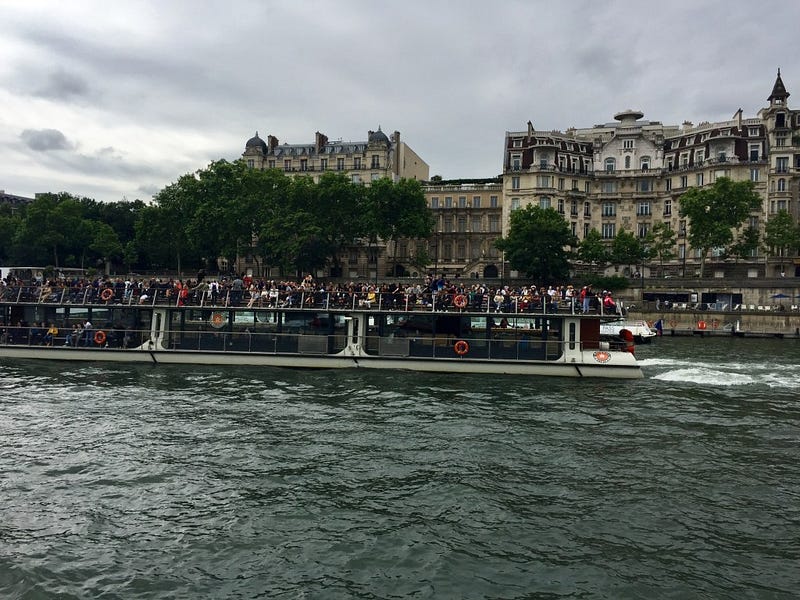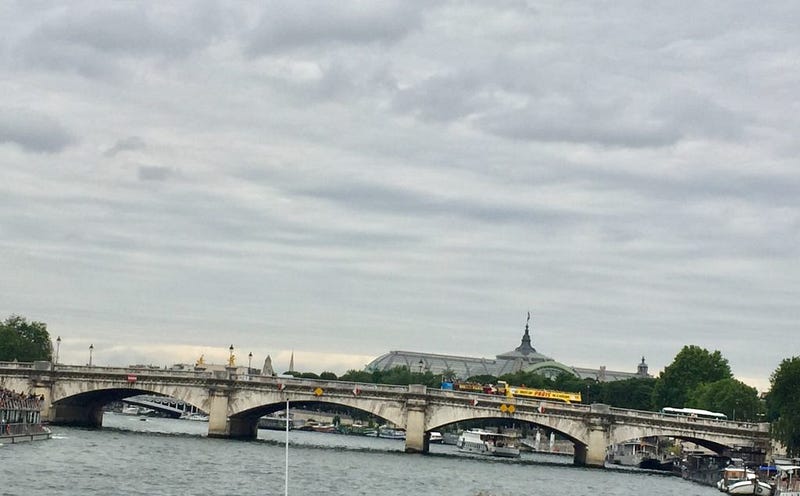We were going to spend the next four days in Paris. “Have you heard of Paris Syndrome?” my niece asked me over the phone.
“No. What is it?”
“Many people when visit Paris say that it didn’t live up to their expectations. So be mindful. Lower your expectations.”
“I shall.” I said that, but I was secretly hoping to see Paris as I had seen in ‘Devil Wears Prada.’ I wanted to see the dreamy wide boulevard where trees were lined with fairy lights, the one Anne Hathaway walked in the last scene of ‘Devil Wears Prada.’
Paris Syndrome A Reality
My husband and I took a train from London to get to Paris. When we arrived at the Paris terminal, I noticed the glass panels on the ceilings were not as clean as Paddington station in London. Okay. No big deal. They are probably due for a clean-up soon.
We stood in line to get a taxi. The line was long and taxis were coming in very slowly. After an hour later we decided to walk to the main road where we would catch a cab quicker. We rolled our suitcases, walked to the front of a hotel and managed to hail a cab, but in the next ten minutes, it moved just ten inches and the meter clocked up ten Euros.
We got of the cab, paid ten Euros and walked back to the train station to get to the metro. The metro map mounted on a wall of the station was in French. We couldn’t figure out where we were. The big yellow arrow saying ‘You are here was missing.
Thankfully another tourist came. He was as clueless as us but knew where we were on the map. We were at Gare du Nord, one of the big terminus metro stations. Paris mainline network has six large terminus stations and is not easy to figure out. Our hotel was just four kilometers away, but we needed to change the train twice to get to Place Charles de Gaulle.
We spotted a pub at the street corner on the way to the hotel, which was bustling with a Thursday night crowd. Great, this is where we can eat. We checked in, refreshed and came to the pub around ten pm. It didn’t have any spare seats. Many people were sitting on the wooden benches of the nearby fruit shop. The atmosphere was electric. People were drinking fancy cocktails. Some were even kissing the waiters. Great, we are at the right place. All we wanted was nice food.
We waited for a seat to become available and placed an order for the best food in the house. By the time it arrived, it was midnight and we were starving. My husband had ordered a steak and I, a chicken dish. Both meals were massive. We were happy. This is going to be the best meal so far.
It was the worst.
Was this part of Paris Syndrome?

Arc de Triomphe
The next morning, we decided to walk to Arc de Triomphe, which was not far from our hotel. We walked on the Avenue de Wagram for half an hour, but there was no sign of the Arc.
Rain started. We took shelter and consulted our map. It turned out that we had been walking in the wrong direction.
While it was under construction, Napoleon had a wooden replica built, in 1810, so that he and his second wife, Marie Louise of Austria, could pass underneath it when they entered Paris for the first time as a married couple.
The Arc was finally inaugurated on July 29, 1836, 30 years after it was first commissioned. In 1840, Napoleon finally got to pass under the completed arch — when his body was taken to its final resting place.
It is an intricately sculpted masterpiece. Relief sculptures at the base of its four pillars depict four victories and several war scenes.
The top of the arch lists the names of successful battles during the Revolutionary and Napoleonic periods.
Less significant battles are inscribed on the inside walls, along with the names of 558 generals. The soldiers who died in battle, their names were underlined.
On November 10, 1920, an unknown soldier who died in the First World War was buried under the arch. An eternal flame was lit to honor those who died in this conflict.
Since then, the flame is lit each evening to honor the fallen.
A few weeks after World War II, aviator Charles Godefroy flew a Nieuport fighter plane through the arch to honor the airmen who lost their lives in World War II.
Boat tour of the river Seine
We took a boat tour of the river Seine which was turned out to be an excellent way to see the main buildings between the Eiffel Tower and Saint-Louis Island.
The tour started from the Vedettes du Pont Neuf on City Island. You can walk to that point from the Louvre Museum.
The first building we spotted was Louvre, the famous museum. Louvre was first built as a fortress in the 12th century to protect the city of Paris. When it was no longer useful as a fortress, Louvre was turned into a royal palace. Then in the 18th century, when Louis XIV moved to Versailles, Louvre became the museum.

The river Seine has 37 bridges. We crossed under many of those. The first one was The Royal Bridge. It is one of the oldest bridges in the city. It was a gift from King Louis XIV to the people of Paris to make up for the expensive building work of Versailles.
Next was the Concord Bridge which is a symbolic bridge. It was built with the stones from the Bastille prison after it was destroyed during the French Revolution in1789.





Pont Alexander III is considered the most beautiful bridge in Paris. It was built for World Fair in 1900. It celebrates Franco-Russian friendship.
It has a gilded coat of arms of St Petersburg on one side and the Coat of arms of Paris on the other side.

The Invalides Bridge is the lowest bridge on the Seine and it was built to celebrate the victories and battles of Napoleon.

Next was the Modern Alma Bridge, which was rebuilt in the 1970s. That is why it is called the modern bridge. It still has the old famous sculpture called the Zouave. Parisians used to measure the level of the river by this statue. During the great flood of 1910, the water reached Zouave’s neck, while in June 2016, it came up to its belt only.
Finally, the Eiffel Tower, the most famous monument of Paris,became visible. It was built to celebrate the centenary of the French Revolution. When it was presented at the world fair in 1889, Parisian hated it. They thought it was ugly and would collapse one day. Now they are very proud of it. It has become the symbol of France.
Initially, it was built for 20 years only. In 1906 it was about to be demolition. But by that time they the radio and TV antennas mounted on it. There was no other place as high as Eiffel Tower to put them. So the authorities decided to keep the tower.
One thousand high and ten thousand tons heavy, Eiffel Tower was the highest monument in the world for a long time. Today it is considered as a work of art. by Gustave Eiffel, by whose name it is still known as.

Our boat took a ‘U’ turn from the Effiel Tower and we went back in the direction we came from.
On the way, we spotted the Gilded Flame. Itis an exact copy of flame from the Statue of Liberty in New York. It was a return gift from the United States to France for the Statue of Liberty.
Gilded Flame is very close to the tunnel where Princess Diana died. Most people think it’s a memorial dedicated to her.
On the way back, from the boat, we could see the roof of The Grand Palace, which was built for the World Fair in 1900. Its impressive glass roof weighs 8,500 tons, almost as much as Eiffel Tower.
It is so big that there used to be car and horse races organized inside. Now it is used to hosts exhibitions and fashion shows.

Now we had started moving in the other direction towards Notre Dame Cathedral and Saint-Louise Island.
We went underneath a bridge called the New Bridge. The New Bridge is in fact, the oldest bridge in Paris. It was built in the 17th century. It was called the New Bridge because it was the first bridge to walk and enjoy the view over the Seine. In those days, houses used to be built all along the bridges because they thought it was better for the foundations. A pedestrian bridge was something new hence the name the New Bridge.
It has funny and ugly faces all along with it, which are known as mascarons. They represent the friends and ministers of King Henry IV who didn’t believe the bridge was solid enough to stand. The king decided to mock them by installing their scornful faces on the bridge permanently.

We visited Paris when Notre Dame Cathedral was burnt just a couple of months ago. We were disappointed that we couldn’t see it from inside. We could see the scaffolding at the back but thankfully the front was undamaged
Notre Dame Cathedral is the gothic jewel of Paris. It was built between the 12th and 14th centuries and took almost two centuries to complete. It is famous for its statues, gargoyles, stained glass windows, and large rose glass window. It measures thirteen meters across and is made of 32,000 pieces of glass which makes the entire cathedral lit up from inside when the sun hits from the north.

The next bridge to cross was Tournelle Bridge which has the great statue of Sainte Genevieve, saint patroness of Paris. She is carrying a child in her arms which represents the people of Paris.

We sailed past Saint-Louise Island. Saint-Louise Island is the most expensive area in Paris. It has several beautiful mansions dating from the 17th century.
Next, we witnessed The Mary Bridge (the romantic bridge in Paris), the City Hall (where executions used to take place) and the Clock Tower (that houses the oldest public clock in Paris dating from the 14th century).
Then came in view the majestic building of the Conciergerie. It was initially a Royal Palace and was turned into a jail in the 14th century.
Queen Marie Antoinette spent the last two months of her life here before she was beheaded.

By this time I had forgotten all about The Paris Syndrome. I was happy in the city of dreams. I will write more about Paris in my next few posts.


